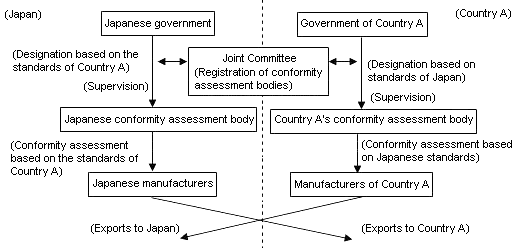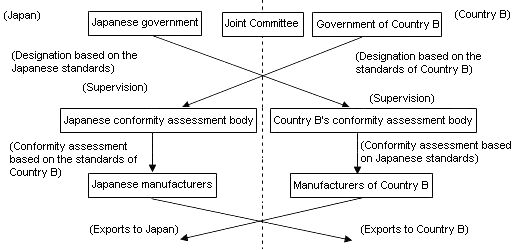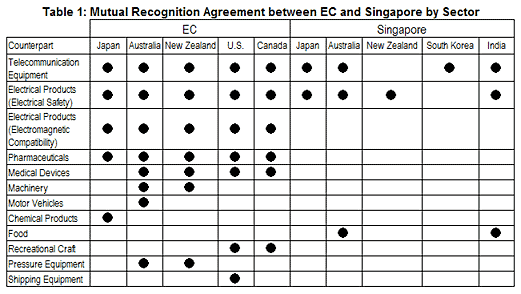Mutual recognition arrangements as a policy tool began to draw attention from scholars of international trade law in the 1990s and academically have been held in high regard. However little has been examined using an empirical approach on the implementation and practical use of these arrangements. This study 1 focuses on the mutual recognition system under the Japan-Singapore Economic Partnership Agreement (JSEPA) as a case study, whereby a series of interviews were conducted with concerned individuals from the two countries to examine how and under what conditions the negotiations proceeded and to what extent the agreement has been implemented to date. This study finds that in contrast to the general perception of mutual recognition, a mutual recognition arrangement is essentially a continuing learning process generated by two countries through mutual understanding on each other's laws and regulations. What has also become apparent is that developing an institutional mechanism for facilitating the use of the mutual arrangement system by companies is a major policy challenge.
Mutual recognition arrangements may either be in the form of an independent mutual recognition agreement (MRA), as is the case for the Agreement on Mutual Recognition between Japan and the European Community, or they may constitute part of a regional trade agreement (RTA) as with the JSEPA. For the purpose of this article, however, no distinction is made between them.
Academic understanding of mutual recognition arrangements
Mutual recognition arrangements are generally understood as falling somewhere between "negative integration" and "positive integration" in terms of a policy approach. Negative integration is to ensure market access by simply removing discrimination; by way of a negative test of whether certain trade barriers in question are discriminatory. Positive integration is an approach in which multiple countries seek to achieve economic integration by implementing coordinated and common policies, for instance harmonizing laws and regulations by transferring regulatory authority to an international organization. Mutual recognition is closer to negative integration in that it seeks to ensure market access, though not by a negative test but by an agreement for countries to accept one another's products. At the same time, it is similar to positive integration in that countries concerned positively cooperate to examine whether they can accept each other's products in view of the equivalence of regulations and testing methods. Because of the extreme difficulty in achieving harmonization, the mutual recognition system - a scheme that seeks to ensure market access (more vigorously than would be achieved by the mere principle of nondiscrimination) while allowing for different laws and regulations among countries concerned - has come to be understood as an important policy tool for implementing "market governance."
The dichotomy of negative and positive integration has first been used by Dutch economist Jan Tinbergen. 2 As he introduced the concept in the context of economic integration, the current idea of mutual recognition is placed in the long experience of the European Community from the 1970s through 1990s, starting from the proposal of harmonization followed by its failure and subsequent course corrections. Such development within the EC has had spillover effects to countries and regions outside the EC. In the 1970s, when the EC was vigorously promoting harmonization, the United States feared that harmonization among countries within the EC would result in the discriminatory treatment of those outside of them. This sense of fear is said to have been one of the triggering factors for concluding the so-called Standard Code under the General Agreement on Tariffs and Trade regime, the predecessor of the Agreement on Technical Barriers to Trade (TBT Agreement) under the World Trade Organization. Furthermore, in the 1980s when the EC to a degree shifted away from harmonization policy by partially adopting a mutual recognition approach, MRAs began to be concluded worldwide. The U.S. is said to have initiated the move toward concluding its MRA with the EC driven by the concern that certain EC policies might impede U.S. exports.
Background of negotiations for JSEPA
Singapore has been taking a proactive stance on government-to-government MRAs. Table 1 shows major MRAs concluded by the EC and by Singapore by area of industry. As observed in this table, inclusion of telecommunications equipment and electrical products under the MRA coverage appears to be a global trend. Negotiations of the JSEPA were launched in March 2000 by a joint study group of experts that included business, academia, and government members from the two countries. Like Japan, Singapore shifted weight to RTAs following the failure of the WTO Ministerial Conference in Seattle. As far as mutual recognition arrangements are concerned, however, Singapore had already arranged mutual recognition in a RTA context with New Zealand and was also in the process of negotiating for an independent MRA with Australia. Singapore launched negotiations for mutual recognition with New Zealand and Australia mainly because these three countries were collectively promoting a mutual recognition arrangement for electric and electronic equipment under the framework of the Asia-Pacific Economic Cooperation.
Japan, for its part, was not totally inexperienced with mutual recognition arrangements either. Japan and the EC began MRA negotiations in 1995 and reached a basic agreement by the end of 2000, prior to entering into full-scale negotiations for JSEPA (the Japan-EC MRA was signed in April 2001 and put into force in April 2002). When Japan was engaged in lengthy MRA negotiations with the EC, problems in Japan's legal system were frequently reported in the media. One article noted, "Coordination within the country is making little headway because 'this is an issue that requires a fundamental shift in the standards and certification system of Japan' according to a senior official of the Ministry of Foreign Affairs." 3 One specific example of the "fundamental shift" is to amend the Electric Appliance and Material Safety Law by introducing a third party certification system for products in Japan; a system already prevalent in the EC. 4 Third-party certification is a conformity assessment system in which a neutral, non-governmental organization conducts an assessment as to whether a product is in accordance with the safety technology standards of the importing country. Prior to the law revision, only specific public entities designated by the government were authorized to provide testing and certification services in Japan. Under the revised law, any registered testing agency - even foreign or private-sector - can provide such services. With such a background, Japan and Singapore launched negotiations for the JSEPA, which was signed in January 2002. As shown in Table 2 , the two countries adopted a mutual recognition scheme identical to that of the Japan-EC MRA.

Actually, this type of mutual recognition, which is globally prevalent, is not for recognizing laws and regulations relevant to certain product safety technology, but for recognizing conformity assessment procedures governed by the relevant laws and regulations. As defined in ISO/IEC 17000, "conformity assessment" is the "demonstration that specific requirements relating to a product, process, system, person or body are fulfilled" and the mainstream practice in industrialized countries is to have these procedures carried out by conformity assessment bodies - neutral third parties. Mutual recognition on the level of conformity assessment procedures eliminates the need for a company to apply for testing and certification by an assessment body of the country to which it wishes to export its products. Instead, it can apply for testing and certification by a registered body in its home country, thereby completing the entire procedure prior to exporting. The government of an importing country must unconditionally accept the results of the assessment carried out by a registered body of an exporting country as equivalent to those obtained from a domestic one.
Implementation of JSEPA
The JSEPA took effect on November 30, 2002. The core element in the implementation of mutual recognition is a designation of conformity assessment bodies. Ultimately, Japan and Singapore have each designated a body for electrical products. Specifically, the Japan Quality Assurance Organization (JQA) was registered in February 2004 and PSB Corporation in September 2004 in Singapore. On the other hand, the implementation of mutual recognition for telecommunications equipment has yet to materialize as there is no assessment body registered for such products.
The difficulty in designating conformity assessment bodies lies in the fact that each government must, at the stage subsequent to agreeing to mutual recognition arrangements, study and acquire a precise understanding of the laws and regulations of the other country. Generally in the context of mutual recognition, the designation of a conformity assessment body is tantamount to having the government of an exporting country "undertake accreditation and supervision on behalf of the government of an importing country," that is, letting the government of an exporting country "posses certain functions of the government of an importing country," according to the Conformity Assessment Division of the Industrial Science and Technology and Environment Bureau at the Ministry of Economy, Trade and Industry (METI). Specifically, in the case of mutual recognition for electrical products under the JSEPA, the relevant regulatory authority in Japan (METI) is to designate conformity assessment bodies in accordance with the safety standards of Singapore. The system is such that the government of one country is not able to designate a conformity assessment body without having very precise knowledge of the laws and regulations of the other country. This represents the crucial stage for the government of each country to learn and understand the relevant regulatory laws of the other. Also, in the process of the negotiation and implementation of mutual recognition, this is the stage where administration costs are most concentrated.
Yet the system has materialized after a great deal of work and effort and the next important step would be to enter it into practical use to the benefit of the industrial community. However, in the field of electrical products, for which conformity assessment bodies have been registered in the both countries, neither of the registered bodies has issued a single certificate. That is to say, these bodies have yet to receive any applications from companies. Actually, the situation of the Japan-EC MRA is not so different in terms of the number of such certificates issued. Following the effectuation of the Japan-EC MRA in January 2002, JQA was registered as a conformity assessment body in November 2002. As of March 2006 only 37 certificates had been issued by JQA.
Prospect
A study on international trade emphasized the difficulty in the negotiation process of the U.S.-EC Mutual Recognition Agreement (signed in 1998) as follows: "Negotiation of the MRAs was just the beginning of the process. Many issues remained open and required further discussions to determine the terms of the implementation." 5 Therefore, the difficulties that surfaced in the JSEPA are not confined to Japan and Singapore. Mutual recognition is a process of understanding and sharing regulatory systems and it may be in such learning process thus the significance of concluding an MRA should be recognized. Yet, that the fact is it takes a long way before truly operational institutions can be built. And if so, academic assessment of mutual recognition must take this into account.
Means of reducing administrative costs are also being sought. Mutual recognition utilizing an offshore assessment body (see Table 3 ) is seen as one way to achieve that end. Under this system, a conformity assessment body in the exporting country is designated by the government of the importing country based on its own safety standards. This system has been considered as compared to the conventional system in which the government of the exporting country must understand the safety standards of the importing country and designate a domestic conformity assessment body based on those standards. Such a shift in the mutual recognition mechanism is counted on to reduce the administrative costs that have been inflated by the need to understand the other country's regulations. Close attention should be paid to how mutual recognition, a policy that has been drawing a great deal of attention since the 1990s, will develop over time.




